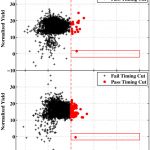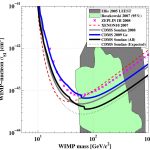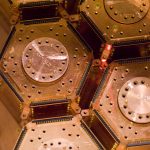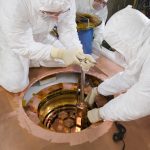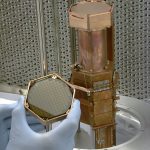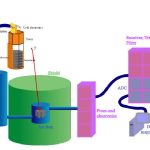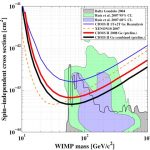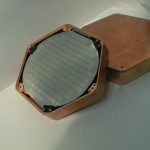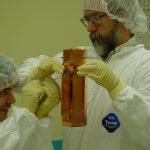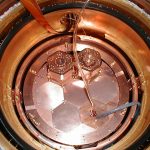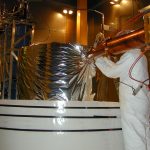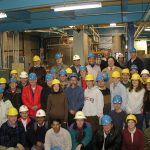U.S. experiment retakes the lead in competitive race
Batavia, Ill.—Scientists of the Cryogenic Dark Matter Search experiment today announced that they have regained the lead in the worldwide race to find the particles that make up dark matter. The CDMS experiment, conducted a half-mile underground in a mine in Soudan, Minn., again sets the world’s best constraints on the properties of dark matter candidates.
“With our new result we are leapfrogging the competition,” said Blas Cabrera of Stanford University, co-spokesperson of the CDMS experiment, for which the Department of Energy’s Fermi National Accelerator Laboratory hosts the project management. “We have achieved the world’s most stringent limits on how often dark matter particles interact with ordinary matter and how heavy they are, in particular in the theoretically favored mass range of more than 40 times the proton mass. Our experiment is now sensitive enough to hear WIMPs even if they ring the ‘bells’ of our crystal germanium detector only twice a year. So far, we have heard nothing.”
WIMPs, or weakly interacting massive particles, are leading candidates for the building blocks of dark matter, which accounts for 85 percent of the entire mass of the universe. Hundreds of billions of WIMPs may have passed through your body as you read these sentences.
“We were disappointed about not seeing WIMPs this time. But the absence of background in our sample shows the power of our detectors as we enter into very interesting territory,” said CDMS co-spokesperson Bernard Sadoulet, of the University of California, Berkeley.
If they exist, WIMPs might interact with ordinary matter at rates similar to those of low-energy neutrinos, elusive subatomic particles discovered in 1956. But to account for all the dark matter in the universe and the gravitational pull it produces, WIMPs must have masses about a billion times larger than those of neutrinos. The CDMS collaboration found that if WIMPs have 100 times the mass of protons (about 100 GeV/c2) they collide with one kilogram of germanium less than a few times per year; otherwise, the CDMS experiment would have detected them.
“The nature of dark matter is one of the mysteries in particle physics and cosmology,” said Dr. Dennis Kovar, Acting Associate Director for High Energy Physics in the U.S. Department of Energy’s Office of Science. “Congratulations to the CDMS collaboration for improved sensitivity and a new limit in the search for dark matter.”
The CDMS experiment is located in the Soudan Underground Laboratory, shielded from cosmic rays and other particles that could mimic the signals expected from dark matter particles. Scientists operate the ultrasensitive CDMS detectors under clean-room conditions at a temperature of about 40 millikelvin, close to absolute zero. Physicists expect that WIMPs, if they exist, travel right through ordinary matter, rarely leaving a trace. If WIMPs crossed the CDMS detector, occasionally one of the WIMPs would hit a germanium nucleus. Like a hammer hitting a bell, the collision would create vibrations of the detector’s crystal grid, which scientists could detect. Not having observed such signals, the CDMS experiment set limits on the properties of WIMPs.
“Observations made with telescopes have repeatedly shown that dark matter exists. It is the stuff that holds together all cosmic structures, including our own Milky Way. The observation of WIMPs would finally reveal the underlying nature of this dark matter, which plays such a crucial role in the formation of galaxies and the evolution of our universe,” said Joseph Dehmer, director of the Division of Physics for the National Science Foundation.
The discovery of WIMPs would require extensions to the theoretical framework known as the Standard Model of particles and their forces. On Feb. 22, the CDMS collaboration presented its result to the scientific community at the Eighth UCLA Dark Matter and Dark Energy symposium.
“This is a fantastic result,” said UCLA professor David Cline, organizer of the conference.
The CDMS result tests the viability of new theoretical concepts that have been proposed.
“Our results constrain theoretical models such as supersymmetry and models based on extra dimensions of space-time, which predict the existence of WIMPs,” said CDMS project manager Dan Bauer, of DOE’s Fermilab. “For WIMP masses expected from these theories, we are again the most sensitive in the world, retaking the lead from the Xenon 10 experiment at the Italian Gran Sasso laboratory. We will gain another factor of three in sensitivity by continuing to take more data with our detector in the Soudan laboratory until the end of 2008.”
A new phase of the CDMS experiment with 25 kilograms of germanium is planned for the SNOLAB facility in Canada.
“The 25-kilogram experiment has clear discovery potential,” said Fermilab Director Pier Oddone. “It covers a lot of the territory predicted by supersymmetric theories.”
The CDMS collaboration includes more than 50 scientists from 16 institutions and receives funding from the U.S. Department of Energy, the National Science Foundation, foreign funding agencies in Canada and Switzerland, and from member institutions.
Fermilab is a DOE Office of Science national laboratory operated under contract by the Fermi Research Alliance, LLC. The DOE Office of Science is the single largest supporter of basic research in the physical sciences in the nation.
NSF is an independent federal agency that supports fundamental research and education across all fields of science and engineering. NSF funds reach all 50 states through grants to more than 1,700 universities and institutions.
CDMS home page
http://cdms.berkeley.edu/index.html
- In these figures, the dotted red line divides events into those determined not to be WIMPs based on the relative timing of the heat to charge signals (left side) and those that could potentially be WIMPs based on that parameter (right side). The solid red box delineates the area of the graph in which WIMPs should occur based on both timing and the heat to charge ratio. Two events in separate detectors demonstrated the characteristics scientists predicted a WIMP would have. Credit: CDMS
- The curves dipping through this figure represent the results of several dark matter search experiments. The vertical scale represents the rate of WIMP scatters with nuclei while the horizontal scale is the mass of the WIMP. The gray line represents the 2008 results from the CDMS experiment. The blue line represents the most recent CDMS results. The solid black line represents the two results combined. The dotted black line represents the curve the combined results would have formed if CDMS had found no candidate events in 2009. The green and gray backgrounds represent areas that two theories of supersymmetry predict would contain dark matter. Credit: CDMS
- Dark matter detectors. The Cryogenic Dark Matter Search experiment uses five towers of six detectors each. Credit: Fermilab
- Dan Bauer, CDMS project manager and Fermilab scientist, removes one tower of detectors used in the Cryogenic Dark Matter Search experiment. Credit: Fermilab
- Closeup of a CDMS detector, made of crystal germanium. Credit: Fermilab
- The CDMS detectors, made of germanium, are located inside an ice box. A fridge provides the coolant to keep the detectors at close to absolute zero. Shielding material around the icebox minimizes the number of cosmic rays and other background particles that hit the detectors. Credit: CDMS collaboration
- The CDMS experiment has achieved the world’s most stringent limits on how often dark particles interact with ordinary matter and how heavy they are, in particular in the theoretically favored mass range of more than 40 times the proton mass (about 40 GeV/c2). The regions excluded are those above the solid lines. The black line is the most stringent limit. The bottom axis indicates the WIMP mass and the left axis refers to the frequency with which WIMPs interact with ordinary matter.
- Closeup of a detector in its mount. A detector of this kind, made of Silicon, was operated in the 1998 run. The photolithographically-fabricated thin film on the surface is the phonon sensor and represents a significant advance over the detectors used in the 1999 run. Silicon and germanium detectors, weighing 100 g and 250 g respectively, are used in CDMS II runs in the Soudan Mine.
- Project manager Dan Bauer from Fermilab holds one tower of detectors as Vuk Mandic, now at the University of Minnesota, examines them. Each tower of detectors contains 1 kilogram of germanium for detecting dark matter and 200 grams of silicon to distinguish WIMPs from neutrons. Thin layers of silicon, aluminum, and tungsten covering the detector surfaces measure both the heat and charge released when a particle interacts inside.
- A view of the inner layers of the cryostat with two towers installed. Detector towers are mounted in the holes covered by hexagonal plates. The coldest part of the cryostat stays at 10 mK (millikelvin, or thousandths of a degree above absolute zero) during operation. The surrounding layers are higher temperature stages of the cryostat. The cryostat is constructed using radiopure copper to provide a low-radioactivity environment for the extremely sensitive CDMS detectors.
- A scientist examines the shielding around the cryostat.
- The first detectors arrive at the Soudan Mine on February 21, 2003.
- A collaboration meeting at Soudan in March, 2003. The 12-institution collaboration includes 45 scientists.
- The Soudan Underground Mine was closed in 1963 and placed on the National Register of Historic Places in 1966. It is operated as a State Park by the Minnesota Department of Natural Resources, with 14 tours a day taking the historic elevator for a fast and clamorous ride nearly a half-mile below the surface. After descending, hard hat-wearing tourists can view old mine caverns with some of the equipment still standing in place. Since May 2002, tourists can also view the cavern housing the CDMS detector.
- Soudan is part of Minnesota’s Iron Range. Rich ore deposits were discovered in the area in 1865. Today, underground mines have largely given way to surface mining. The Soudan Underground Mine has served as a physics laboratory since 1979. The photo shows the view from the top of the tower above the Soudan Mine shaft.
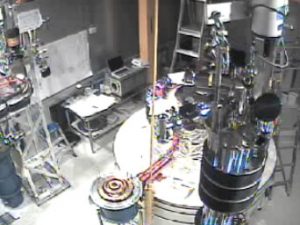
This video (1 min.) shows a time lapse of the construction of the CDMS experiment in 2003-2004. Watch video (QuickTime movie. May not work in all browsers.)
Credit: Priscilla Cushman
Background information
What is dark matter?
Judging by the way galaxies rotate, scientists have known for 70 years that the matter we can see does not provide enough gravitational pull to hold the galaxies together. There must exist some form of matter that does not emit or reflect light. Ordinary matter (made of quarks) makes up only 15% of the matter contents in the universe. An unknown form of dark matter makes up 85%. (In terms of the full matter and energy content of the universe, ordinary matter contributes 4%, dark matter makes up 23% and dark energy represents 73%.)
Most of the ordinary matter is invisible, too. It exists across the universe in form of hydrogen, dust clouds and very dim clumps of matter called massive compact halo objects. These MACHOs include planets and cold dead stars like brown dwarfs and black holes.
Neutrinos, very light particles left over from the big bang in massive quantities, make up a small amount of the dark matter that is not made of quarks. WIMPs, or weakly interactive massive particles, may make up the rest. Neutrinos move at nearly the speed of light. That’s why they are considered “hot dark matter.”
What is a WIMP?
Weakly interactive massive particles may make up most of the dark matter, if they have a mass of 10 to 10,000 times the mass of the proton. They only interact with ordinary matter via gravity and a weak force (not the strong or electromagnetic force), so they only disturb atoms when they collide with a nucleus. Atoms contain mostly empty space, so this rarely happens. As many as 10 trillion WIMPs should pass through one kilogram of the Earth in a second but perhaps as few as one per day will interact.
What is supersymmetry?
The Standard Model describes all of the particles and forces in the universe, but it does not adequately explain the origin of mass. To solve this problem, in 1982 some theorists proposed an extension to the Standard Model where every mass particle (the quark, electron, etc) and every force-carrying particle (the photon, graviton, etc.) has an associated “superpartner” that differs only in its spin and mass. Since we have not yet detected superpartners, they must be much more massive than the particles observed so far.
The lightest neutral supersymmetric particle is the neutralino. With an expected mass of 50-1,000 billion electron volts (GeV) – the mass of a proton is 1 GeV — and weak interaction with everyday matter, the neutralino is a prime candidate for being a WIMP.
If it is a WIMP, it travels through the universe at 1/1000 the speed of light, making it “cold dark matter.” Neutralinos were produced at the beginning of the universe but exist in fewer numbers than the neutrino because their great mass makes them harder to produce, and they annihilate each other. Both types of particles pass through the Earth in large quantities.
How does the CDMS experiment work?
The experimental set-up for the Cryogenic Dark Matter Search contains five towers of detectors. Each tower contains germanium for detecting dark matter and silicon to distinguish WIMPs from neutrons. The CDMS towers have a total of four kilograms of germanium. Supersymmetry models predict that only a few WIMPs per year, one per day at most, will interact with the detectors. The biggest challenge involves sorting them from background interactions due to electrons, neutrons, and gamma rays.
When a WIMP hits a germanium nucleus, the nucleus recoils and vibrates the whole germanium crystal. This warms the thin aluminum and tungsten outer layers, which an electrical circuit measures. Photons and electrons, however, strike the germanium’s electrons. A charge collection plate measures ionization resulting from this type of collision and uses it to separate these interactions from those of WIMPs. The ratio of charge to heat for each event tells whether a particle struck the nucleus, as WIMPs do, or simply rattled the electrons surrounding the nucleus, as most background particles do.
Incoming neutrons also strike the germanium nucleus, so they more closely resemble WIMPs. The germanium detectors sit in a stack with detectors made of silicon. A silicon atom has a smaller nucleus, and so will be hit less frequently by WIMPs. The strong nuclear force does not affect WIMPs, but it does affect neutrons and so neutrons will hit nuclei of different sizes at about the same rate. A higher collision rate in the germanium than the silicon will indicate the interaction of WIMPs.
Why is the CDMS experiment underground?
Cosmic rays hit the surface of the Earth and the reactions produce neutrons. Placing the detectors deep underground shields them from most of the cosmic rays that would produce neutrons.
Why are the CDMS detectors so cold?
A cryostat cools the detectors to 40 millikelvin (thousandths of a degree above absolute zero.) This reduces the background vibrations of the detector’s atoms and makes them more sensitive to individual particle collisions.
Institutions participating in CDMS:
Brown University
California Institute of Technology
Case Western Reserve University
Fermi National Accelerator Laboratory
Lawrence Berkeley National Laboratory
Massachusetts Institute of Technology
Queens University
Santa Clara University
Stanford University
Syracuse University
University of California, Berkeley
University of California, Santa Barbara
University of Colorado Denver
University of Florida
University of Minnesota
University of Zurich




